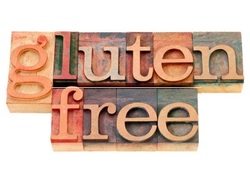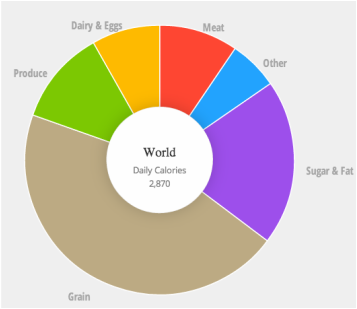TO BREAK, OR BREAK UP WITH, BREAD
12/5/2014
By: Dr. Courtney Holmberg, ND  Unless you've been living under a rock, I'm sure you've come across the ingredient every product is labelling free-of and every consumer is trying to avoid, gluten. One of the most common questions I'm asked with regards to dietary changes in practice is "should I be gluten-free too?" Stats say roughly 29% of households now have a family member who eats gluten free, and the "Gluten Free" label has become the top 5th label claim since 2011. But when asked, less than a third of respondents (including those who claimed to be gluten free) actually knew what gluten was and where it was found. So... what is it? Why is it bad for us? And what's with all the hype anyways? There are a number of articles circling the web on either side of the gluten fence. I'm not here to persuade you, but to inform you, so listen closely. FIRST OFF... WHAT IS GLUTEN? Gluten, by definition, is a family of proteins, made up of gliadin and glutenin that give bread its elasticity, or ability to rise. The family that seems to be problematic in today's diet is found in wheat, barley and rye. Dr. Tom O'Bryan, a certified gluten practitioner in the US, discusses the reason for its "toxicity". He states that although not everyone may show symptoms of sickness from eating gluten, the human body does not produce intestinal enzymes to break down the gliadin component of the protein [1]. For someone with celiac disease, this is a serious problem. Their immune system produces an anaphylactic response when exposed to the gluten protein (even in minute amounts)... much like someone would with a bee allergy, but in their gut. These people often carry a gene that predisposes them to this condition, and a gluten-free diet is absolutely essential for them. The interesting fact is that there has been a 4 fold (or 400x) increase in the incidence of celiac disease over the past 50 years [1]. That leaves us with the question.... WHY IS GLUTEN SUDDENLY A PROBLEM? Although wheat hasn't changed, and has been cultivated now for roughly 10000 years, its been only in the last 500 years that the actual content of gluten in wheat-based foods has gone up [2]. This is because gluten helps breads rise and holds food together, making for better texture, and is therefore actually added to foods already containing gluten. It can also be found in cosmetics, hair products, and household cleaners. Its important to note that although only 3% of the those with the celiac gene actually develop celiac disease, roughly 30% of the population carries the gene. So why isn't everyone developing celiac? Tom O'Bryan states this is due to the concept of loss of oral tolerance - meaning over exposure and weakened gut health due to environmental factors may be the key to expression of this gene [3] The World's Food Habits Chart in 2013, from vox.com
10 Comments
 Cravings: those intense, urgent desires for sweet and salty snacks. If cravings are the culprits standing in the way of your optimal health and slim down goals, well, you’re not alone. Whether it be a late night sugar fix, a calling for carbs or salty snacks – out of control cravings wreak havoc in healthy habit endeavours all too often. Discover how to kick cravings to the curb for good, in just 3 simple steps. Those poor cravings, they don’t stand a chance! 1) Know your triggers One of the most powerful ways to stop a binge is before it begins. Start by keeping a food journal to help indicate which foods could be causing your cravings. Be mindful of these common food triggers: □ Coffee □ Diet Coke or diet beverages □ Dried fruit □ Oatmeal □ Wheat □ Alcohol Is your sweet tooth sabotaging your goals? Well, it’s no coincidence because high-sugar foods increase your levels of ghrelin, a hormone that stimulates appetite and increases cravings. 2) Balance blood sugar Do you find it impossible to finish the day without a little something sweet? In order to bust this type of craving, blood sugar levels need to be stabilized throughout the entire day. Here is a handy dandy tip to help you - eat 3 in 3′s. What does this mean? Eat a balanced meal of protein, healthy fats and high fiber/ low glycemic carbohydrates, every three hours. Set a timer to remind you fuel up and wait for that craving to be ninja kicked to the curb. Need help planning some balanced meals? I’m here to help: □ 1 cup plain Greek yogurt + 2 tbsp of chia seeds + 1 cup raspberries (or mixed berries) □ 2 whole eggs + 2 tbsp avocado on whole grain toast □ Shake with 1 scoop of protein powder with 2 tbsp of chia seeds + mixed berries □ Lean, grass fed (organic) meat , baked sweet potato drizzled with coconut oil 3) Question your cravings “When you have cravings it’s a result of multiple physiological triggers that come together to signal you to eat, usually a sugary or salty food. In fact, the signal to eat can sometimes be so strong that no amount of willpower can overcome it.” However understanding why you have food cravings, gives you power over them. If carbs are your crutch when you’re feeling bored, sad, angry or stressed – stop blaming yourself. Put simply, carbohydrates calm us. This is due to the fact that they secrete serotonin, our feel good hormone. So it makes sense that when you’re feeling down, that your body instinctively asks for bagels, pasta and doughnuts. But this surge of good emotions is quickly followed by a crash. Cue - guilt, shame and frustration. So when carbs come a callin’:
When making your exchanges, be sure to match texture and taste in order to successfully bust cravings. □ Salty: Kale chips, dehydrated zucchini, sweet potato crisps, raw crackers (see: recipe of the week) □ Chocolate: Add cacao to smoothies/pudding. □ Ice cream: Try frozen coconut based smoothie □ Pasta: The next time you’re at the health food shop – pick up mung bean noodles or kelp noodles. Claire LeGresley, RHN And to receive a weekly newsletter with nourishing tips like these plus recipes & food for thought, be sure to sign up for Wellness Wednesdays here. To Gluten, or not to Gluten?
7/22/2013
 To Gluten, or not to Gluten?- that seems to be the question these days. Odds are you have heard about Gluten, and due to the vast amount of varying information out there you may still be wondering what it’s all about. If you are like me and a few foodie friends of mine you know it’s a protein found in foods processed from wheat and related grain species, including barley and rye. If you’re like my cousin you may be thinking, “Isn’t that a thing found in carbs that is suppose to be unhealthy for you?” And if you’re like my dad, you may think something like “that sounds like the technical term for your bum muscles…”, sorry dad, that’s a different article entirely, back to gluten: Over the past few years there has been an increased awareness and adoption of wheat and gluten free diets. Some of the perceived benefits of a wheat or gluten free diet include, alleviation from chronic stomach pains, bloating, heartburn, joint pains, headache, skin rashes, fatigue, insomnia and brain fog. People adopt a gluten free diet for various reasons: some are diagnosed with Celiac’s or have wheat sensitivities, others are trying to lose weight, and others still claim that a gluten free diet has improved their health even though they test negative to Celiac Disease. More and more health professionals are recognizing something called non-celiac gluten-sensitivity. The difference between non-celiac gluten-sensitivity and Celiac’s is that people with non-celiac gluten-sensitivity have celiac-like symptoms but no autoimmune reaction to gluten. This means that they may experience the exact same symptoms as those with Celiac’s from eating gluten, yet currently there is way to detect the illness except by eliminating gluten and seeing if the symptoms resolve. Assessing your body’s response to gluten is therefore best done by eliminating gluten for a few weeks and gradually re-introducing it. If the symptoms disappear and then re-appear, it could mean you have non-celiac gluten-sensitivity. In this case, you may want to talk about how to start an elimination diet with your health professional. What about healthy individuals without sensitivity to gluten- is a gluten free diet a healthier option? While it is often thought that the gluten free diet is healthier for the entire population, there has been no credible research on a cause and effect relationship between wheat free/gluten free diets and our health. Further, the weight loss/gluten relationship is more complex then most of us understand; individuals with a gluten free intolerance or Celiac’s typically lose weight prior to following any treatments because of their digestive issues affecting absorption, and in fact typically gain weight once following a gluten free diet. Furthermore, while there are healthy gluten free options available, many gluten -free packaged products are often high in saturated fat, sugar and sodium. Many gluten free products also have less fiber and fewer vitamins. With that said, those who must follow a gluten free diet for medical reasons can eat healthfully on a gluten free diet with some planning and education, however, healthy individuals not needing to follow a gluten free diet for any particular reason are probably better off not adopting this diet. Talk to your nutritionist and health professional about what the best fit for you is. - Elis Halenko, R.D |
AuthorPosts inspired by the team at Platinum Health & Wellness. Archives
June 2025
Categories
All
|
|

 RSS Feed
RSS Feed